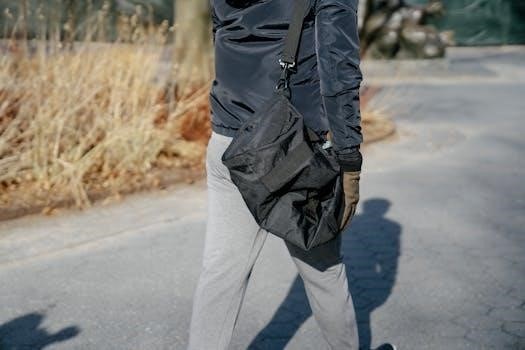Embark on a creative journey into drawstring bag sewing! These versatile bags are perfect for beginners. They offer endless possibilities for customization. Discover the joy of crafting functional and stylish bags with ease using our free PDF patterns.
Brief Overview of Drawstring Bags and Their Uses
Drawstring bags are simple pouches closed with a drawstring. They are incredibly versatile and easy to sew, making them a favorite for beginners and experienced sewers alike. These bags can be used for a variety of purposes including gift wrapping, travel storage, organizing small items, carrying books, or even as a lightweight backpack. Their adaptability makes them perfect for eco-friendly solutions and personalized projects. Many free PDF patterns online offer a starting point.
Free Drawstring Bag Patterns⁚ PDF Downloads
Unlock a world of sewing possibilities with free drawstring bag patterns available for PDF download! These patterns cater to all skill levels. Start crafting your own personalized bags today with easy-to-access resources online.
Accessing Free PDF Patterns Online
Discovering free PDF patterns for drawstring bags is easier than you think. Many designers and craft websites offer complimentary patterns for personal use; Simply search online for “free drawstring bag pattern PDF.” Be sure to check reputable sewing blogs and online crafting communities. Look for patterns that include clear instructions and diagrams. Always confirm the pattern’s copyright allows for your intended use before downloading and printing.
Mindy Makes Free Resource Library
Mindy Makes offers a treasure trove of free resources. You can find a fantastic selection of drawstring bag patterns within their free resource library. Access various sizes and styles designed for different purposes. These patterns often come with detailed step-by-step instructions. They also include helpful diagrams to guide you through the sewing process. Subscribe to Mindy Makes’ newsletter to unlock access to this valuable resource library. Start crafting your perfect drawstring bag today!
Materials Needed for Sewing a Drawstring Bag
To begin your drawstring bag project, gather essential materials. You’ll need fabric, a drawstring cord, thread, scissors, and a sewing machine. A free PDF pattern will provide the dimensions for cutting your fabric pieces accurately for your project
Fabric Selection⁚ Types and Amounts
Choosing the right fabric is essential for your drawstring bag. Lightweight cotton twill, linen, or quilting cotton are excellent choices for beginners. Consider using leftover fabrics or scraps to create a patchwork design. For a mini bag, a 9.5×4 inch piece may suffice, while medium bags require two 6.5×9 inch pieces. Most bags will require less than half a yard, making it a budget-friendly project.
Drawstring Cord Options
Selecting the right drawstring cord can significantly impact the bag’s functionality and appearance. Consider using cotton twill tape, ribbon, or paracord. For a more rustic look, try using jute twine. Ensure the cord’s width is appropriate for the channel you create. Pre-made drawstrings are readily available, or you can create your own using fabric scraps. Experiment with different colors and textures to personalize your drawstring bag.

Step-by-Step Sewing Instructions
Follow our comprehensive, step-by-step instructions to create your own drawstring bag. From cutting the fabric to inserting the drawstring, each step is clearly explained. You’ll have a beautiful, handmade bag in no time.
Cutting the Fabric According to Pattern Dimensions
Begin by downloading and printing your chosen free PDF pattern. Ensure accurate scaling to achieve the intended bag size. Lay your fabric flat on a cutting surface. Then, carefully position the pattern pieces according to the layout instructions. Use scissors or a rotary cutter to precisely cut along the pattern lines. Remember to add seam allowances if they aren’t already included in the pattern. Accuracy here ensures a well-constructed, professional-looking finished bag.
Sewing the Bag Sides and Bottom
With your fabric pieces cut, align the side edges of the main bag pieces with right sides together. Use pins or clips to secure them in place. Using a sewing machine, stitch along the sides with the seam allowance indicated in your pattern. Pivot at the bottom corners to create a seamless join. After sewing the sides, sew the bottom edge. Reinforce the seams by backstitching at the beginning and end. This ensures durability and prevents unraveling.
Creating the Drawstring Channel
The drawstring channel is essential for threading the cord. It allows the bag to close securely. Precise folding and sewing ensure a clean, functional channel. This step defines the bag’s closure mechanism and overall aesthetic appeal.
Folding and Ironing the Top Edge
Carefully fold over the top edge of the bag to create a clean, even hem. Ironing this fold secures it, making sewing easier and more precise. This step is crucial for a professional-looking finish. It establishes the foundation for the drawstring channel. A well-ironed edge ensures a smooth, even casing. This will guide the drawstring effortlessly. Accuracy here enhances the bag’s durability and aesthetic appeal, setting the stage for the next sewing steps.
Sewing the Channel Seam
Stitch along the folded edge to form the drawstring channel. Maintain a consistent seam allowance for an even look. Leave a small opening to insert the drawstring later. Backstitch at the beginning and end to secure the seam. This creates a sturdy casing that will withstand wear and tear. Ensure the opening is large enough for your chosen drawstring cord. This step defines the functionality of the bag. A well-sewn channel ensures smooth drawstring movement. It also ensures the bag closes securely every time.
Inserting the Drawstring
Now, bring your bag to life by inserting the drawstring! This crucial step secures the bag’s closure. Explore various threading methods. These methods will efficiently guide the cord. Secure the ends for a polished finish. Enjoy your functional creation!
Methods for Threading the Drawstring
There are a few clever methods for threading the drawstring through the channel. A safety pin attached to the drawstring end is a classic choice. This allows easy maneuvering through the fabric tunnel. Alternatively, a bodkin or specialized threading tool works wonders. These tools grip the cord securely. This guides it smoothly along the channel. Consider using a large-eyed needle for thicker cords. Select the method that best suits your materials; Ensure a seamless and frustration-free process!
Securing the Drawstring Ends
Securing the drawstring ends prevents fraying and ensures durability. A simple knot at each end is a quick fix, choose a tight knot; For a more polished look, consider using cord ends or aglets. These metal or plastic tips crimp onto the drawstring. They provide a clean, professional finish. Another option is to stitch the ends together. This creates a loop, reinforcing the closure. No matter your method, ensure the ends are securely fastened. This will enhance the bag’s longevity and aesthetic appeal.

Adding a Flat Bottom to the Bag
Adding a flat bottom enhances the bag’s structure. This allows it to stand upright. It also increases the usable space inside. Creating a flat bottom involves a few simple steps. This adds both functionality and a professional touch.
Creating Corner Triangles
To form the flat bottom, begin by flattening one bottom corner of the bag. Align the side seam with the bottom seam. This creates a triangle shape at the corner. Measure and mark a line across the triangle. This line will determine the width of the flat bottom. Ensure both corners are identical for a symmetrical base. Pin the fabric along the marked line to keep it in place before sewing. This step is critical for achieving a balanced and functional flat bottom.
Sewing and Trimming the Corners
Carefully sew along the marked line on each corner triangle. Use a straight stitch for durability. Backstitch at the beginning and end of the seam to secure the stitches. Once sewn, trim away the excess fabric, leaving about 1/4 inch seam allowance. Zig-zag stitch the edges of the seam allowance. This prevents fraying and adds strength. Repeat this process for both corners. Turn the bag right side out. The flat bottom should now be visible and well-defined, enhancing the bag’s stability.
Drawstring Bag Sizes and Dimensions
Explore various drawstring bag sizes, from mini to large, with adaptable dimensions. Our free PDF patterns include measurements for each size, ensuring a perfect fit for your needs. Customize patterns for unique dimensions.
Mini, Small, Medium, and Large Bag Dimensions
Our free PDF drawstring bag patterns offer dimensions for mini, small, medium, and large sizes, providing versatility for various uses. The mini bag is perfect for small trinkets, while the small and medium sizes work well for gifts or travel. The large bag is ideal for carrying books or groceries. Access all dimensions within the MindyMakes Free Resource Library.
Adjusting Pattern for Custom Sizes
Need a unique size? Altering our free PDF drawstring bag patterns is simple. To adjust the height, add or subtract length from the main rectangle. For a wider bag, increase the width of the rectangle. Remember to adjust the drawstring length accordingly. Ensure your fabric amount matches the new dimensions. Experiment with different sizes to create personalized bags for any purpose!
Embellishment and Customization Ideas
Unleash your creativity by embellishing your drawstring bags! Add unique touches with embroidery, fabric paint, or appliques. Experiment with different fabrics and textures. Personalize your bags to reflect your individual style and make each one special.
Patchwork Designs
Transform fabric scraps into stunning patchwork designs for your drawstring bags! Piece together various colors and patterns to create a unique, eye-catching effect. Patchwork is a fantastic way to utilize leftover fabrics from other projects, adding a sustainable and personalized touch. Experiment with different patchwork techniques, such as squares, triangles, or even more intricate geometric shapes. Consider using a dessert roll to create your patchwork masterpiece. Let your creativity flow and design a truly one-of-a-kind drawstring bag.
Adding Pockets
Enhance the functionality of your drawstring bag by adding pockets! Incorporate an outer pocket for easy access to frequently used items like keys or phones. You can also sew inner pockets to organize smaller belongings. Consider a simple patch pocket or a zippered pocket for added security. Use contrasting fabrics to make the pockets stand out. Personalize your bag with pockets tailored to your specific needs. Adding pockets not only increases the bag’s utility, but also adds a stylish design element. Enjoy having a practical and organized drawstring bag!

Drawstring Backpack Variations
Transform your basic drawstring bag into a convenient backpack! By adding straps, you create a hands-free carrying solution. Explore design modifications, such as adding outer pockets. Customize the backpack to suit your personal style and needs with ease.
Adding Straps for Backpack Style
Transform a simple drawstring bag into a functional backpack by strategically attaching straps. Begin by measuring and cutting two lengths of sturdy cording or fabric strips suitable for shoulder straps. Position and secure the straps to the bottom corners of the bag, ensuring even weight distribution. Reinforce the attachment points with multiple rows of stitching for added durability. For comfort, consider padding the straps. This simple alteration converts a basic bag into a convenient backpack.
Including an Outer Pocket
Elevate your drawstring bag by adding an accessible outer pocket for storing smaller items. Cut a rectangular piece of fabric for the pocket, hemming the top edge for a clean finish. Position the pocket on the main bag fabric before sewing the bag together. Stitch along the sides and bottom of the pocket, leaving the top open. Reinforce the corners for added durability. Consider adding a snap or Velcro closure for extra security. This simple addition enhances the bag’s functionality.

Using Drawstring Bags for Gifts
Transform your presents with personalized drawstring bags! These bags offer an eco-friendly and charming alternative to traditional wrapping paper. Create unique, reusable gift bags that add a special touch to any occasion, reflecting your thoughtfulness.
Eco-Friendly Gift Wrapping
Embrace sustainable gifting with drawstring bags! Ditch disposable wrapping paper and opt for reusable fabric bags. These bags minimize waste and add a personal touch. Choose fabrics that reflect the recipient’s style. Consider organic cotton or recycled materials for an even greener approach. These charming bags become part of the gift, encouraging reuse and reducing environmental impact. Add embellishments for extra flair and create a truly memorable and eco-conscious present!
Personalized Gift Bags
Elevate your presents with personalized drawstring gift bags, adding a unique touch to any occasion. Monogram the bag with the recipient’s initials for a sophisticated touch. Appliqué their favorite motifs or characters for a playful design. Use fabric markers to create custom artwork or heartfelt messages. Choose colors and patterns that resonate with their personality. Add embellishments like beads, buttons, or lace for extra flair. Personalized gift bags transform ordinary presents into cherished keepsakes, making every gift-giving experience truly special and memorable.
Troubleshooting Common Sewing Issues
Even seasoned sewers face snags. This section addresses common drawstring bag sewing issues. Discover solutions for fabric puckering, uneven channels, and more. With these tips, you’ll overcome challenges and achieve flawless results on every project.
Fabric Bunching or Puckering
Fabric bunching or puckering can be frustrating when sewing drawstring bags. This issue often arises from uneven fabric feed or incorrect tension settings on your sewing machine. Ensure your fabric is smooth and taut as you sew, and consider adjusting the pressure foot. Experiment with different stitch lengths to find the optimal setting for your chosen fabric. Stabilizing lightweight fabrics with interfacing can also help prevent bunching and ensure a smoother, more professional finish. Remember to always test on scrap fabric first!
Uneven Drawstring Channel
An uneven drawstring channel can cause the drawstring to pull awkwardly or not function smoothly. This often happens due to inconsistent folding or sewing. Precisely measure and iron the top edge before folding to ensure uniformity. Use a seam gauge to maintain a consistent channel width. When sewing the channel seam, keep a steady hand and follow the edge closely. Reinforce the beginning and end of the seam with backstitching for added durability. If the channel is too tight, the drawstring won’t move freely; if it’s too loose, it will gather excessively.

